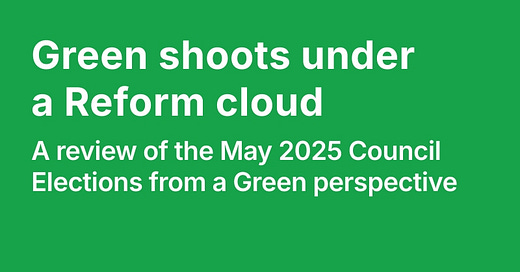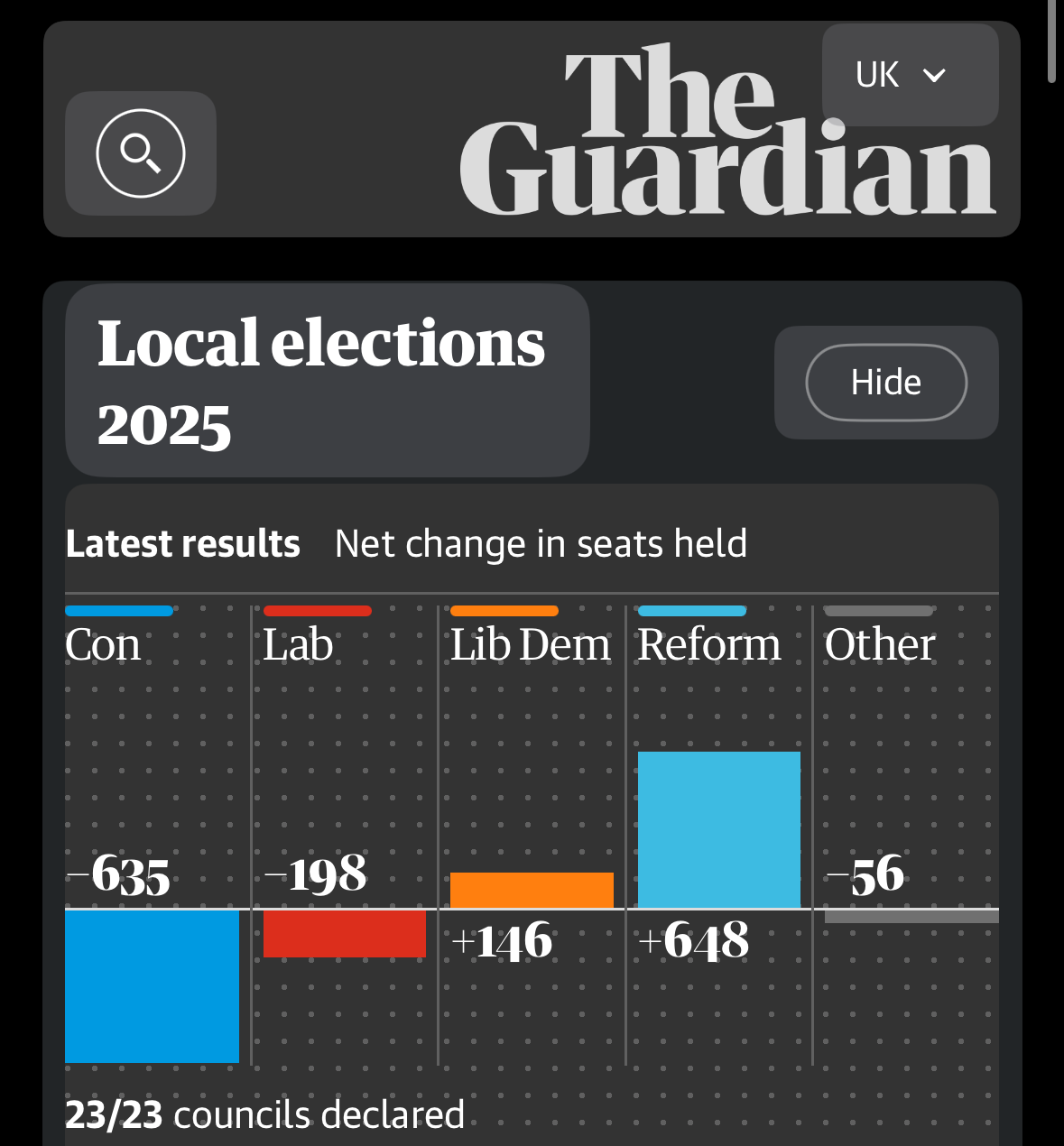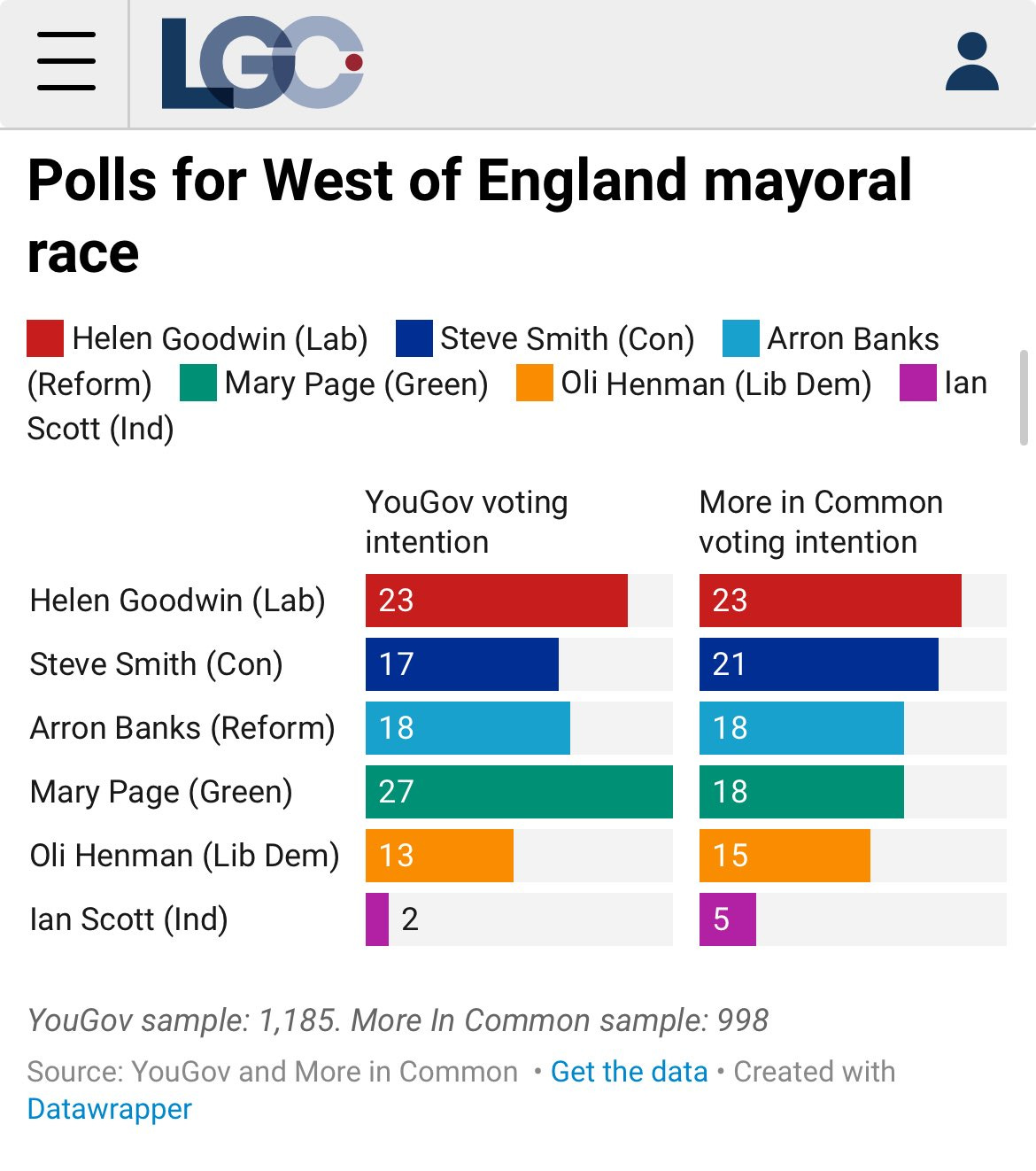Green shoots under a Reform cloud
A review of the May 2025 Council Elections from a Green perspective
It was the best of times…
As the results came in for the Greens on Friday, I was so happy to see all the holds and wins announced across the country, and having helped out with the by-election in Lambeth, it was particularly good to see that win as well.
It was the worst of times…
On Saturday morning, nursing a small hangover from the by-election party the previous night, I turned to the Guardian to see how the results were being portrayed, and was presented with this:
Great, we were being lumped in with “Other”. Now I realise that I should know better than to expect even the nominally left-wing part of the mainstream media to give the Greens any publicity, so instead I turned to the alternative left-wing Novara Media - surely they would have some more perspective, including actually talking to some Greens? Er, no - just Michael Walker talking to Aaron Bastani, and that was it.
After lunch and a trip to “Goya to Impressionism” at the Courtauld Gallery, my hangover had gone, so I thought I’d risk a bit of doomscrolling. And among the left-wing commentariat, the assessment was mostly negative. Owen Jones, riffing off a Guardian article, was particularly blunt.
So, depending on which way you looked at it, the Greens’ results were a kind of Rorschach test - you either saw them as having:
Extended their record-breaking run of council election victories, more than doubling the number of councillors they had elected across the councils being contested; or
Had a terrible night, mere also-rans who couldn’t profit from Labour’s failings and who should give up now because Reform already had the 2029 General Election win nailed on.
Applying some perspective
I’ve had a go at the left-wing commentariat before over their frankly bizarre treatment of the Greens, so I’m going to build on that analysis by focusing on these elections. Let’s start by rewinding to last year.
The path to May 2025
The Greens worked incredibly hard in the first half of 2024, increasing our councillors by 74 in the Local Elections, and then quadrupling our MPs in the General Election. So while we were elated, we were also exhausted - personally and financially - and we needed time to recover and refocus.
In the early autumn, the Greens would have turned their attention to fixing their targets for May 2025 (note that while I have been involved in multiple previous targeting decisions, I wasn’t for this cycle, but am fairly confident that the same process will have been followed). At that point, c. 2,200 councillors were to be elected. I expect that the decision-making process went as follows.
Political Context
Labour had won a huge majority in the General Election, and (despite early missteps) looked like they would at least be reasonably competent technocrats. The Tories were still in the middle of a protracted leadership election, and while Reform polling was creeping upwards, it was still at levels at which the FPTP system would constrain their number of election victories. Labour had also not reintroduced the Supplementary Vote for the Mayor contests, so they were all being run under First-Past-the-Post.
Targeting Decisions
Only the West of England Combined Authority (WECA) Mayor contest was even worth considering as a target, and even there, in 2021 the Greens’ had come third with a first-choice vote only 2/3rds that of Labour. WECA also has an electorate nearly 10 times that of the next biggest campaign the Greens had ever run in that region - 683k vs. 70k for the Bristol Central constituency.
The only region that has routinely run campaigns of this scale is London for the Mayor and Assembly elections, and as they are always 2 years apart from London’s council elections, the region can plan these campaigns two years in advance, selecting candidates and recruit teams of 4-5 staff a year out from the election, and raising budgets of c. £200k for the whole campaign (a massive amount by Green standards!) And this investment in the London campaign is worthwhile because London elects Assembly Members using Proportional Representation.
A decision to target WECA would have resulted in the diversion of time and money from multiple highly winnable councillor election campaigns, would have meant starting the campaign late, and would have been a very high-risk FPTP contest
Based on the scope of the election at that point, there were c. 64 Green incumbents that needed to be defended, and based on the rough trend of targeting over twice as many as we have incumbents, I expect we would have been aiming for 110-160 wins total. Although campaigns on this scale are now routinely achievable by the Greens, that is only by committing the full field (staff) team in these areas and all available volunteer time and money.
WECA candidate change
Less than two months after selection, Heather Mack, the Greens’ candidate for WECA Mayor, stepped down in January 2025, replaced by Mary Page. I don’t know the background to this, so will take at face value that Heather “stood down from her candidacy to allow her to focus on her council role”. I’ll just note that, had the Greens been running this as a target campaign, then much of the investment that would have been put into Heather as a candidate would have been lost.
Labour moves the goalposts
Just before Christmas, Labour published its English Devolution White Paper. What then became apparent by February was that Labour was going to use this as a justification for postponing/cancelling c. one third of the elections that were due to take place, to 1,637. As the areas affected included ones of relative strength for the Greens, this reduced the number of Green councillors up for election by 40%, from c. 64 to 39, and presumably dropped the number of Green target wards by a similar proportion. As this happened so late in the campaign, and as the Green campaign approach relies on canvassing and leafleting for c. a year ahead of an election, I doubt it was possible to mobilise many (any?) additional target campaigns in the areas still being contested.
Context and Results from the Green Perspective
We all know that this election delivered the “Reform quake”, with the Tories and Labour losing c. two-thirds of their councillors, and the LibDems and Green c. doubling their councillors. I think it will be instructive to compare and contrast the two “insurgent” parties’ approaches and positioning in the political system to understand and judge the results (noting the other parties where relevant).
Total Candidates
The Greens stood a record number of candidates for this cycle…
…but it was still the least of the major parties, with Reform achieving near universal coverage.
Clearly, if we aren’t standing a candidate, people can’t vote for us.
First-Past-the-Post strikes again
We know that FPTP disproportionately favours the winning party, and in this election, that meant Reform were very much the beneficiary, gaining 41% of the councillors on 31% of the vote. Conversely, the Greens achieved c. 5% of the councillors on c. 9% of the vote. Of the other parties, only the LibDems overperformed relative to vote share (22% of councillors vs. 17% of the vote).
If only Labour and the Tories would learn from this and start advocating for Proportional Representation…and back to reality.
Ground Campaigns, Field Organisation and Money
The Greens have in Target to Win (TTW) a proven campaigning methodology that plays to the Greens’ strengths. It compensates for a lack of digital tools, demographic information etc. by ruthlessly focusing effort where it will have the most impact.
But Reform has other options. As I highlighted in this earlier article:
Reform is moving quickly towards a political strategy based on winning elections outright. Its field operations are nascent but are clearly improving in both breadth and competency. If Reform adds effective field organising to its existing money, media access and membership numbers (and doesn’t implode under the weight of Farage’s ego), it will be very hard to beat.
Unfortunately, this is proving to be an increasingly accurate forecast. I’ve seen reports from Greens of Reform employing half a dozen Field Organisers in a county where the Greens can afford only a single part-time Field Organiser. And this analysis of the Runcorn by-election demonstrates how Reform is taking these advantages to the next level (my additions in square brackets):
Reform has the broadest possible support of any insurgency party right now. War chest, it seems, too. And it fed on that which has long been felt by the voters - "You are ignored, you don't matter to them. Show them you won't be ignored."
I write these sentiments glibly, but in truth they make up what the actual Reform campaign was. The strategy was as follows. Target those with a history of not voting, and a demographic profile to suggest they should [Greens cannot afford the data, tools and time to do this analysis], and work on their pride. Signed letters made their way to these voters long in advance [Greens cannot afford mailshots]. Personalise the letter. Humanise the voter. Whereas other campaigns with limited resources [e.g. the Greens] focus on the regular voters, writing off the non-voting and instead sticking to the old reliable “base”; Reform, coming from nowhere, did the opposite. When Reform activists turned up to turn them out on polling day, they had already gone and done it.
Every other party should be very worried by the capability that Reform is developing - I certainly am.
Incumbent Councillors and Target Candidates
Given how punishing FPTP is to a party that gets a small national vote share, the Greens’ results are well above what would have otherwise been expected:
We retained 87% of our incumbent councillors, which is a testament to how much our communities value our councillors.
Rigorous targetting, relentless campaigning and strong candidates resulted in winning an additional 46 councillors (resulting in 41 net additional councillors).
This is in no small part due to our TTW process, because it requires a candidate and their team to commit a year or more ahead of an election to campaigning consistently for and in their community, embedding the candidate in that community, and ensuring that once elected the candidate carries that effort on into their work to represent their community.
Reform, conversely, had no incumbents in this election, and many of their candidates were elected with little direct campaigning. I guess that many did not even expect to get elected, so I believe that many of them will not have the staying power once the difficult decisions and hard graft of casework kick in.
Media and Leadership
There is no doubt that Reform has benefited from what are in effect its own media platforms (GB News, Daily Mail, the Telegraph etc.), and favourable social media, both of which are then magnified by the rest of the mainstream media.
And let’s be blunt - the media (mainstream and alternative, left and right) at best de-platforms the Greens, and at worst actively denigrates them - e.g. one of the few Guardian articles specifically on the Greens in the last few months was this:
This was about a personal issue that started over a year ago involving one Green councillor in a non-target ward!
Novara Media’s election review was a good example of how the left alternative media treat the Greens. On it, Aaron Bastani actually acknowledged how powerful and partisan right-wing media is (c. 29 minutes in), while yet again not including anyone from the Greens - with friends like these etc.
Finally, there has been a lot of crititicism of the Carla and Adrian’s leadership - but as newly elected MPs, they have had to get grips with the arcane nonsense of our Parliament, and even if they had been better at e.g. social media content, I’ve yet to see any evidence it would have made a fundamental difference to the overall level of coverage received by the Greens.
Conclusions and Lessons
We are getting really good at delivering TTW
We selected well, our candidates and their teams worked hard and followed the plan, so we retained the vast majority of our incumbents and we more than doubled our number of councillors - that is a good result, and a testament to the effectiveness of our approach and our increasing capability to deliver it.
We need to keep reinforcing the message that TTW works to the remaining sceptics within the party (there are still some).
We also need to communicate how effective TTW is to members who are not yet consistently actively supporting our campaigns.
WECA would have been a step too far
Controversial, I know, but I think that the party made the difficult but right decision not to target WECA.
A campaign launched in late autumn would have started too late, would have redirected too much resource away from winnable council elections (noting that many more council seats were up for election at that point as the Devolution Bill had not then been tabled) and into a high-risk campaign.
Although some late polls (e.g. YouGov) teased us with the possibility of a win for the Greens, other polls (e.g. More in Common) much more accurately predicted the result.
Prepare for by-elections - lots of them!
As Reform has elected many unprepared candidates, we can expect many by-elections over the next 4 years, so we need to be ready to launch by-election campaigns where we have a realistic chance of winning.
Act now to achieve a full slate for May 2026
We need to repeat to our members (and supporters) that we need them to stand, and given the number of candidates needed for May 2026 (c. 4,000 I believe!) we need to start identifying them now.
New Approaches Needed
TTW is great at breaking onto councils and winning/retaining small numbers of councillors. But we now need to develop other approaches:
“Target to Run”: how we campaign to win control of a council administration, or at least win enough to be part of the administration;
“Green Council Leadership”: how we support councillors who are part of an administration, with variants for being a coalition minority partner, coalition majority partner, minority administration and majority administration.
“Large Campaign”: build on the knowledge built up in the London Mayor/Assembly and General Election campaigns to ensure we are ready to contest future Mayor campaigns
Organisational Capability needs to grow - rapidly
Somehow, we need to build the capability to take on the other major parties. A lot of this will be dependent on fundraising, which has always been a huge constraint for the Greens.
As a minimum, we cannot go into the May 2026 campaign without digital canvassing, which means we need action now to get a system ready by early autumn 2025.
But let’s be realistic - there are no easy answers to these challenges.
Final Thoughts
The Tory government deliberately destroyed the financial sustainability of councils, and the Labour government has done nothing to address that. Reform’s “answers” to the problems of local government will only make things worse. Unless and until Labour implements a new approach to funding local government properly, whichever parties are running councils will continue to find themselves being blamed for continuously increasing council tax while services and infrastructure slowly deteriorate.
We are increasingly in a Limits to Growth world, and none of the other parties even acknowledge that. Unfortunately, with the over-centralisation of power and financial control in Westminster, councils are too constrained to themselves implement the Green solutions we need. The best we can do is elect principled, committed Greens to represent the most vulnerable, ameliorate the worst problems and advocate for fundamental change. And as UK politics collapses under the weight of austerity, inequality, resource constraints and ecosystem collapse unless we create a Green alternative, we risk the ascendancy of the far right.
Next Up
I’m aiming to alternate articles on policy issues (AI is up first) and more on how the Greens need to evolve rapidly, both nationally and in London, for May 2026 and beyond.
Appendix - Green Results
Record high number of councillors: 859 seats on 181 councils
Net change: GAIN of 43 seats (including by-elections)
HOLD: 38
GAIN: 48
LOSS: 5
Three more councils with elected Greens:
Leicestershire
Staffordshire
Cambridgeshire
Performance vs other parties:
CON: 24 gains from CON. 0 losses
LAB: 17 gains from LAB, 0 losses
LD: 6 gains, 1 loss
Ref: 0 gains, 4 losses
IND: 3 gains from IND












Hi Colin, great article, great Substack! Personally I think the criticisms of Green social/mainstream media strategy are largely justified, but I do agree that even in this area so much comes down to not having enough money for adequate staffing.
But from my perspective, one of the biggest issues for the Greens right now is your point 5.b (below). Please can you write a whole post on this!
“Green Council Leadership”: how we support councillors who are part of an administration, with variants for being a coalition minority partner, coalition majority partner, minority administration and majority administration.